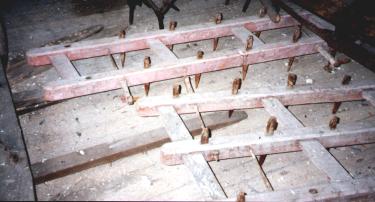Harrows

Harrows are used for several purposes. On grassland, they can be dragged across a pasture field to drag out the dead growth after winter and give the new grass room to sprout. You have probably done this to your garden lawn at some time with a rake or scarifier.
Harrows can be driven over lumpy "rough muck" after it has been forked by hand from a cart, to give an even breakdown of the manure. Breaking down rough muck, and scarifying, are jobs for the "beginner driver."
Harrows can be dragged after ploughing to break down the clods into a fine "tilth" before sowing. This requires more care, so as not to waste effort in covering the ground more than once.
The most accurate kind of harrowing is following the seed drill, to cover the newly sown corn with earth. However, the harrow is a big implement, ten or twelve feet wide, and cannot be steered with handles like a plough. If you drive too fast it bounces and leaves patches untouched. Only good, steady, accurate driving of the horses produces an even coverage of sown seed. Also, there's no reverse... hence John Gate's comment about spring harrowing, that "it took a good man to harrow!"
Our example is a wooden harrow, made in several pieces which were joined together by iron hinges. It is in astonishingly good condition. Usually when wooden implements were replaced with metal ones they lay out forgotten in fields or garths, and their frames rotted under the weather until only the iron teeth and hinges were left. These still-sharp teeth can sometimes be found hammered into walls or beams as harness pegs in farm buildings.
This harrow was found in the rafters of a barn, where it appears to have been put after some use but before its original paint wore off. A nasty thing to have hanging over your head on a winter's evening as you cut out hay to feed the cattle........